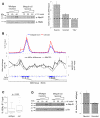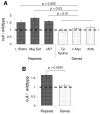Neuronal MeCP2 is expressed at near histone-octamer levels and globally alters the chromatin state
- PMID: 20188665
- PMCID: PMC4338610
- DOI: 10.1016/j.molcel.2010.01.030
Neuronal MeCP2 is expressed at near histone-octamer levels and globally alters the chromatin state
Abstract
MeCP2 is a nuclear protein with an affinity for methylated DNA that can recruit histone deacetylases. Deficiency or excess of MeCP2 causes severe neurological problems, suggesting that the number of molecules per cell must be precisely regulated. We quantified MeCP2 in neuronal nuclei and found that it is nearly as abundant as the histone octamer. Despite this high abundance, MeCP2 associates preferentially with methylated regions, and high-throughput sequencing showed that its genome-wide binding tracks methyl-CpG density. MeCP2 deficiency results in global changes in neuronal chromatin structure, including elevated histone acetylation and a doubling of histone H1. Neither change is detectable in glia, where MeCP2 occurs at lower levels. The mutant brain also shows elevated transcription of repetitive elements. Our data argue that MeCP2 may not act as a gene-specific transcriptional repressor in neurons, but might instead dampen transcriptional noise genome-wide in a DNA methylation-dependent manner.
Copyright 2010 Elsevier Inc. All rights reserved.
Figures






Comment in
-
A bird's-eye view of MeCP2 binding.Mol Cell. 2010 Feb 26;37(4):451-2. doi: 10.1016/j.molcel.2010.02.006. Mol Cell. 2010. PMID: 20188662
Similar articles
-
MeCP2 binds to nucleosome free (linker DNA) regions and to H3K9/H3K27 methylated nucleosomes in the brain.Nucleic Acids Res. 2012 Apr;40(7):2884-97. doi: 10.1093/nar/gkr1066. Epub 2011 Dec 5. Nucleic Acids Res. 2012. PMID: 22144686 Free PMC article.
-
MeCP2 binds cooperatively to its substrate and competes with histone H1 for chromatin binding sites.Mol Cell Biol. 2010 Oct;30(19):4656-70. doi: 10.1128/MCB.00379-10. Epub 2010 Aug 2. Mol Cell Biol. 2010. PMID: 20679481 Free PMC article.
-
Binding of the Rett syndrome protein, MeCP2, to methylated and unmethylated DNA and chromatin.IUBMB Life. 2010 Oct;62(10):732-8. doi: 10.1002/iub.386. IUBMB Life. 2010. PMID: 21031501 Free PMC article. Review.
-
MeCP2 preferentially binds to methylated linker DNA in the absence of the terminal tail of histone H3 and independently of histone acetylation.FEBS Lett. 2008 Apr 2;582(7):1157-62. doi: 10.1016/j.febslet.2008.03.005. Epub 2008 Mar 11. FEBS Lett. 2008. PMID: 18339321
-
MeCP2, A Modulator of Neuronal Chromatin Organization Involved in Rett Syndrome.Adv Exp Med Biol. 2017;978:3-21. doi: 10.1007/978-3-319-53889-1_1. Adv Exp Med Biol. 2017. PMID: 28523538 Review.
Cited by
-
Novel MeCP2 isoform-specific antibody reveals the endogenous MeCP2E1 expression in murine brain, primary neurons and astrocytes.PLoS One. 2012;7(11):e49763. doi: 10.1371/journal.pone.0049763. Epub 2012 Nov 19. PLoS One. 2012. PMID: 23185431 Free PMC article.
-
Epigenetic layers and players underlying neurodevelopment.Trends Neurosci. 2013 Aug;36(8):460-70. doi: 10.1016/j.tins.2013.05.001. Epub 2013 May 31. Trends Neurosci. 2013. PMID: 23731492 Free PMC article. Review.
-
The Use of Induced Pluripotent Stem Cell Technology to Advance Autism Research and Treatment.Neurotherapeutics. 2015 Jul;12(3):534-45. doi: 10.1007/s13311-015-0354-x. Neurotherapeutics. 2015. PMID: 25851569 Free PMC article. Review.
-
Genotype-specific effects of Mecp2 loss-of-function on morphology of Layer V pyramidal neurons in heterozygous female Rett syndrome model mice.Front Cell Neurosci. 2015 Apr 20;9:145. doi: 10.3389/fncel.2015.00145. eCollection 2015. Front Cell Neurosci. 2015. PMID: 25941473 Free PMC article.
-
Bridging the Gap between DNA Methylation, DNA Methylation Readers, and Neurodevelopmental Disorders.J Neurosci. 2016 Jun 29;36(26):6851-3. doi: 10.1523/JNEUROSCI.1130-16.2016. J Neurosci. 2016. PMID: 27358443 Free PMC article. Review. No abstract available.
References
-
- Amir RE, Van den Veyver IB, Wan M, Tran CQ, Francke U, Zoghbi HY. Rett syndrome is caused by mutations in X-linked MECP2, encoding methyl-CpG-binding protein 2. Nat Genet. 1999;23:185–188. - PubMed
-
- Armstrong DD. Neuropathology of Rett syndrome. Ment Retard Dev Disabil Res Rev. 2002;8:72–76. - PubMed
-
- Bading H. Transcription-dependent neuronal plasticity the nuclear calcium hypothesis. Eur J Biochem. 2000;267:5280–5283. - PubMed
Publication types
MeSH terms
Substances
Associated data
- Actions
Grants and funding
LinkOut - more resources
Full Text Sources
Other Literature Sources
Medical
Molecular Biology Databases

